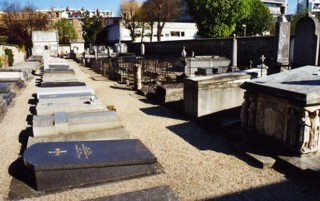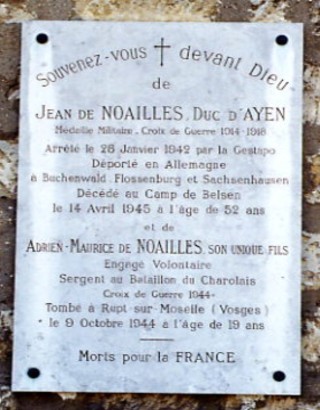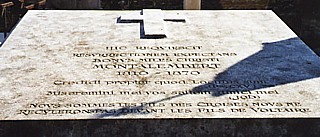


 |
 |
 |
The Count Charles Forbes de Montalembert (1810-1870), historian and politician, is honoured for his part in defending Catholic France and, unsurprisingly, had little enthusiasm for the so-called 'Enlightment'. "Nous sommes les fils des croisés. Nous ne reculerons pas devant les fils de Voltaire", is written on his tomb (photo on bottom left). A defiant chap, old Montalmbert, but he is among his friends here. This is the cemetery of France's oldest noble families. Hidden in the grounds of the convent of the Congrégation des Sacrés-Coeurs et de Marie et de l'Adoration Perpétuelle, it is the only private cemetery in Paris. Opening hours are restrictive and there are no brochures; France's nobility intends to remain discreet, even in death. The custodian is well informed, but says he is forbidden from writing anything on the noble occupants of the place until he retires.
The cemetery is filled with the family mausoleums of some of the most prestigious families of la vieille France. Along one wall are plaques commemorating members of the nobility killed during the Second World War, mostly in concentration camps. Among them: Count Michel de Nodaillac (died, aged 33, at Dora concentration camp); Count Armand de Dampierre (Dora); Princess Anne de Bauffremont Courtenay (Ravensbruck); Count Jacques-Arthus Marc de Montalembert (Mauthausen); the Marquis de Gramont (Dachau); Count Maurice de Jacquelot de Boisrouvray (killed in an air fight over Libya); the Marquis de Laguiche (Buchenwald) and his son, killed in combat in France in August 1944. The story of the death of the Duke d'Ayen (above right is photo of commemerative plaque in Picpus), Jean de Noailles, is one of the most interesting. Though he seems to have had no dealings with the Resistance, the Germans arrested him in January 1942. However, the Duke's family knew some of the Nazi hierarchy in Berlin and started to pull some strings in order to have the Duke released. Highly embarrassed, the Gestapo in Paris denied they were holding the Duke and decided to get rid of him by passing him onto Monsieur Henri's men in the rue Lauriston (see 16th arrondissement). The rue Lauriston gang was instructed to execute the Duke in a spot far away from Paris. Instead, Monsieur Henri used his prisoner to blackmail the Paris Gestapo. Exasperated by the affair, the Germans finally admitted to having arrested the Duke, took him back from Monsieur Henri and packed him off to Buchenwald in January 1944. Jean de Noailles died in Bergen-Belsen in April 1945, just one day before the camp was liberated by the British. His branch of the family has since died out.
Why has the old nobility chosen this piece of ground as their last resting place? Because the bodies of 1306 people, many of them blue-bloods, were dumped here in a mass grave during the Terror. They were all victims of the glorious French revolution, all victims of a guillotine that functioned over a busy six-week period on the nearby Place du Trône (now Place de la Nation). One of the most famous executioners on the Place du Trône, Sanson, is said to have decapitated 54 people in just 24 minutes on June 17, 1794, in the process earning the esteem of many glorious French revolutionaries. Among the nobility thus "disposed of" were the Duke de Clermont-Tonnerre, the Duchess de Gramont, the Prince de la Trémoille, the Princess de Grimaldi, the Duke Créqui de Montmorency, General Alexandre de Beauharnais (Joséphine's husband before Napoléon)., the Prince Frédéric de Salm-Kyrbourg, the Duke de Beauvillier de Saint-Aignan, the Duchess d'Ayen, the Duke de Philippe de Noailles-Mouchy, the prince Victor de Broglie etc...In 1802, the families of the noble families who had fallen victim to the guillotine on the Place du Trône bought a plot beside the mass grave and have been buried there ever since. The place is known to a number of Americans because Général Lafayette is buried here, beside his wife, Marie-Adrienne de Noailles, who lost her mother and daughter in the glorious French revolution.
Among the list of those massacred on the Place du Trône and dumped in Picpus, one finds the odd Irish name, including seaman François-Ursule Burke and his wife (?), a lady called Butler, a servant called John Malone, a "former curate" Pierre O'Brenan and Thomas Ward, provisional brigade general with the Army of the North.
 Return
to home page
Return
to home page  To
top of the page
To
top of the page